The Soluble Milk Protein Market is estimated to be valued at USD 20.7 billion in 2025 and is projected to reach USD 44.6 billion by 2035, registering a compound annual growth rate (CAGR) of 8.0% over the forecast period.
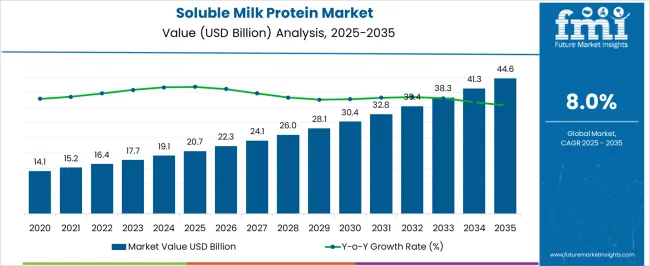
| Metric | Value |
|---|---|
| Soluble Milk Protein Market Estimated Value in (2025 E) | USD 20.7 billion |
| Soluble Milk Protein Market Forecast Value in (2035 F) | USD 44.6 billion |
| Forecast CAGR (2025 to 2035) | 8.0% |
The Soluble Milk Protein market is experiencing steady growth driven by increasing demand for functional and protein-enriched food and beverage products. The current market scenario reflects a shift toward high-protein diets, growing consumer awareness of nutritional benefits, and the rising preference for convenience and ready-to-use protein formulations. Soluble milk proteins are being adopted across a wide range of applications, including dairy-based beverages, nutritional supplements, and bakery products, due to their superior solubility and functional properties.
The market growth is being further influenced by innovations in protein processing technologies, which enable better flavor, texture, and shelf life of end products. Investments in the food and beverage sector, coupled with increasing global consumption of protein-rich foods, are creating significant opportunities.
As consumer interest in health and wellness products continues to rise, the demand for soluble milk proteins is expected to expand across both established and emerging markets Additionally, advancements in sustainable sourcing and production practices are enhancing market appeal and encouraging wider adoption across food manufacturing industries.
The soluble milk protein market is segmented by form, type, end use, source, and geographic regions. By form, soluble milk protein market is divided into Powder and Liquid. In terms of type, soluble milk protein market is classified into Concentrate and Isolates. Based on end use, soluble milk protein market is segmented into Food and beverage processing, Dietary supplements, Sports Nutrition, Infant formula, Health drinks, Protein bars, Bakery and confectionery products, Dairy and ice cream products, Soups, and sauces, Processed Meat Products, Clinical Nutrition, and Pharmaceuticals. By source, soluble milk protein market is segmented into Cow, Goat, Buffalo, Sheep, and Camel. Regionally, the soluble milk protein industry is classified into North America, Latin America, Western Europe, Eastern Europe, Balkan & Baltic Countries, Russia & Belarus, Central Asia, East Asia, South Asia & Pacific, and the Middle East & Africa.
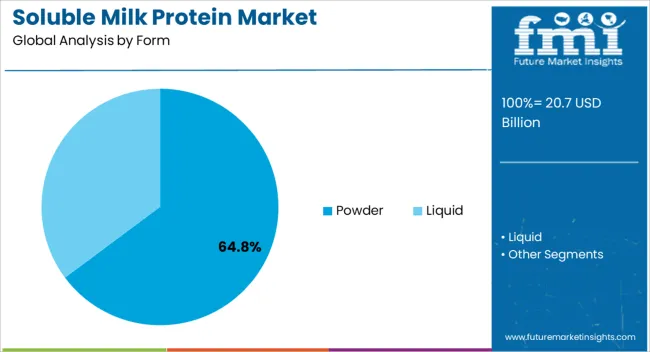
The powder form is projected to account for 64.80% of the Soluble Milk Protein market revenue in 2025, making it the leading form type. This dominance is being driven by its convenience in handling, storage, and formulation in various food and beverage applications. Powdered soluble milk proteins offer extended shelf life and uniform dispersion in liquids, making them highly suitable for industrial-scale processing.
The ability to standardize protein content and maintain functional properties such as foaming, emulsification, and gelling has reinforced its preference over liquid alternatives. The segment has benefited from strong adoption in dairy and nutrition product manufacturing, where high solubility and stability are critical.
Production efficiency, cost-effectiveness, and ease of transport have further contributed to its market share As manufacturers continue to prioritize process optimization and product consistency, the powder form segment is expected to maintain leadership, supported by continued investment in advanced drying and processing technologies that enhance solubility and functional performance.
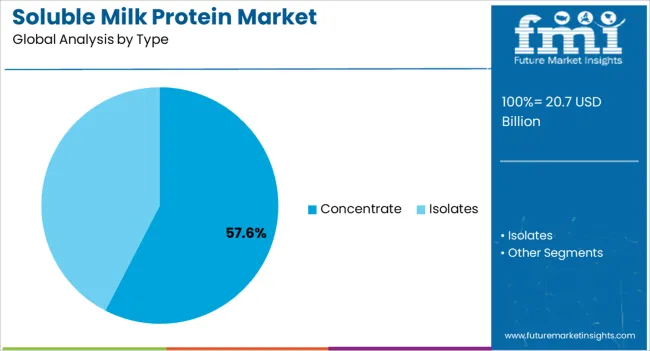
The concentrate type is expected to hold 57.60% of total Soluble Milk Protein revenue in 2025, reflecting its prominence in protein-enriched formulations. This leading position is being attributed to the higher protein content and versatile functional properties of concentrates, which make them ideal for fortifying foods and beverages without compromising taste or texture.
Concentrates provide a balance between protein quality, solubility, and cost-efficiency, supporting wide adoption across industrial and commercial applications. The growth of this segment has been influenced by increased incorporation in ready-to-drink beverages, dairy-based desserts, and bakery ingredients, where nutritional enhancement is a key consideration.
Concentrates allow manufacturers to optimize formulation performance while meeting regulatory requirements for protein labeling The segment’s expansion is also being supported by rising consumer demand for high-protein products, as well as by technological improvements in protein extraction and standardization processes that enhance purity, functionality, and applicability.
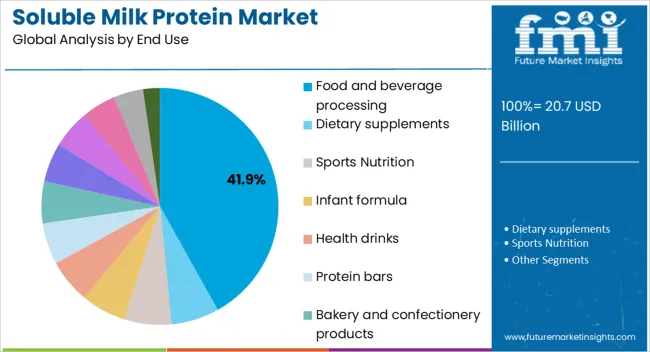
The food and beverage processing segment is projected to account for 41.90% of Soluble Milk Protein market revenue in 2025, establishing it as the largest end-use industry. This dominance is being driven by the integration of soluble milk proteins in a variety of processed products, including beverages, dairy alternatives, bakery items, and nutritional supplements. The segment has benefited from the consistent need for functional ingredients that enhance texture, nutritional content, and stability of finished products.
Manufacturers are increasingly leveraging soluble milk proteins to deliver high-quality, protein-enriched offerings that align with consumer health and wellness trends. The growth is also being supported by rising industrial adoption of ready-to-drink formulations, protein shakes, and fortified foods, which require highly soluble protein ingredients.
As global food processing continues to evolve with an emphasis on convenience, nutrition, and product differentiation, the commercial utilization of soluble milk proteins is expected to expand further The segment’s leadership is reinforced by ongoing investment in ingredient research and formulation innovations that optimize functionality and cost-effectiveness.
Soluble milk protein is present in the aqueous supernatant part of the milk when Casein is precipitated with the help of acid treatment or centrifuged at high speed. Soluble milk proteins are a group of proteins called as whey proteins and consists of β- lactoglobulin, α- lactalbumin, serum albumin, immunoglobulin, lactoferrin, and other minor elements. Soluble milk proteins consist of enzymes, hormones, growth factor, nutrient transporter, disease resistance factors, and other key ingredients.
Milk and milk products have been included in human food consumption for several years, and at the time, more than six billion people consume milk and milk products. Supplementation of soluble milk protein immediately after physical activity has shown improved overall skeletal muscle function compared to casein. As of 2025, food and beverage manufacturers tend to adopt soluble milk protein as a major protein source in sports nutrition, supplements, and other functional health products.
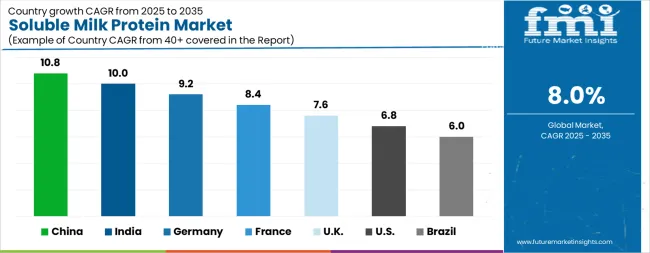
| Country | CAGR |
|---|---|
| China | 10.8% |
| India | 10.0% |
| Germany | 9.2% |
| France | 8.4% |
| UK | 7.6% |
| USA | 6.8% |
| Brazil | 6.0% |
The Soluble Milk Protein Market is expected to register a CAGR of 8.0% during the forecast period, exhibiting varied country level momentum. China leads with the highest CAGR of 10.8%, followed by India at 10.0%. Developed markets such as Germany, France, and the UK continue to expand steadily, while the USA is likely to grow at consistent rates. Brazil posts the lowest CAGR at 6.0%, yet still underscores a broadly positive trajectory for the global Soluble Milk Protein Market. In 2024, Germany held a dominant revenue in the Western Europe market and is expected to grow with a CAGR of 9.2%. The USA Soluble Milk Protein Market is estimated to be valued at USD 7.1 billion in 2025 and is anticipated to reach a valuation of USD 13.7 billion by 2035. Sales are projected to rise at a CAGR of 6.8% over the forecast period between 2025 and 2035. While Japan and South Korea markets are estimated to be valued at USD 1.0 billion and USD 673.9 million respectively in 2025.
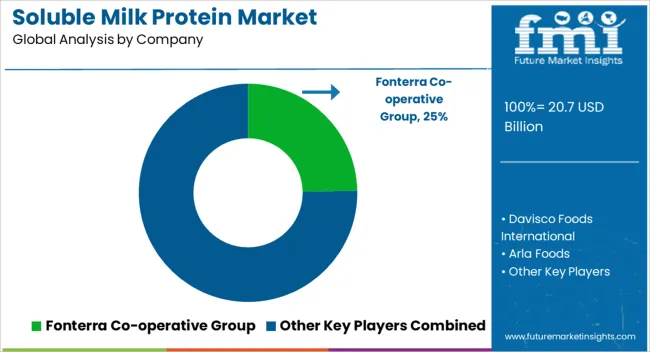
| Item | Value |
|---|---|
| Quantitative Units | USD 20.7 Billion |
| Form | Powder and Liquid |
| Type | Concentrate and Isolates |
| End Use | Food and beverage processing, Dietary supplements, Sports Nutrition, Infant formula, Health drinks, Protein bars, Bakery and confectionery products, Dairy and ice cream products, Soups, and sauces, Processed Meat Products, Clinical Nutrition, and Pharmaceuticals |
| Source | Cow, Goat, Buffalo, Sheep, and Camel |
| Regions Covered | North America, Europe, Asia-Pacific, Latin America, Middle East & Africa |
| Country Covered | United States, Canada, Germany, France, United Kingdom, China, Japan, India, Brazil, South Africa |
| Key Companies Profiled | Fonterra Co-operative Group, Davisco Foods International, Arla Foods, Glanbia PLC, Milk Specialty, and Wheyco GmbH |
The global soluble milk protein market is estimated to be valued at USD 20.7 billion in 2025.
The market size for the soluble milk protein market is projected to reach USD 44.6 billion by 2035.
The soluble milk protein market is expected to grow at a 8.0% CAGR between 2025 and 2035.
The key product types in soluble milk protein market are powder and liquid.
In terms of type, concentrate segment to command 57.6% share in the soluble milk protein market in 2025.






Our Research Products

The "Full Research Suite" delivers actionable market intel, deep dives on markets or technologies, so clients act faster, cut risk, and unlock growth.

The Leaderboard benchmarks and ranks top vendors, classifying them as Established Leaders, Leading Challengers, or Disruptors & Challengers.

Locates where complements amplify value and substitutes erode it, forecasting net impact by horizon

We deliver granular, decision-grade intel: market sizing, 5-year forecasts, pricing, adoption, usage, revenue, and operational KPIs—plus competitor tracking, regulation, and value chains—across 60 countries broadly.

Spot the shifts before they hit your P&L. We track inflection points, adoption curves, pricing moves, and ecosystem plays to show where demand is heading, why it is changing, and what to do next across high-growth markets and disruptive tech

Real-time reads of user behavior. We track shifting priorities, perceptions of today’s and next-gen services, and provider experience, then pace how fast tech moves from trial to adoption, blending buyer, consumer, and channel inputs with social signals (#WhySwitch, #UX).

Partner with our analyst team to build a custom report designed around your business priorities. From analysing market trends to assessing competitors or crafting bespoke datasets, we tailor insights to your needs.
Supplier Intelligence
Discovery & Profiling
Capacity & Footprint
Performance & Risk
Compliance & Governance
Commercial Readiness
Who Supplies Whom
Scorecards & Shortlists
Playbooks & Docs
Category Intelligence
Definition & Scope
Demand & Use Cases
Cost Drivers
Market Structure
Supply Chain Map
Trade & Policy
Operating Norms
Deliverables
Buyer Intelligence
Account Basics
Spend & Scope
Procurement Model
Vendor Requirements
Terms & Policies
Entry Strategy
Pain Points & Triggers
Outputs
Pricing Analysis
Benchmarks
Trends
Should-Cost
Indexation
Landed Cost
Commercial Terms
Deliverables
Brand Analysis
Positioning & Value Prop
Share & Presence
Customer Evidence
Go-to-Market
Digital & Reputation
Compliance & Trust
KPIs & Gaps
Outputs
Full Research Suite comprises of:
Market outlook & trends analysis
Interviews & case studies
Strategic recommendations
Vendor profiles & capabilities analysis
5-year forecasts
8 regions and 60+ country-level data splits
Market segment data splits
12 months of continuous data updates
DELIVERED AS:
PDF EXCEL ONLINE
Milk Protein Market - Size, Share, and Forecast 2025 to 2035
Milk Protein Hydrolysate Market Growth - Infant Nutrition & Functional Use 2024 to 2034
Textured Milk Protein Market Size and Share Forecast Outlook 2025 to 2035
Organic Protein Milk Market
Milk Froth Thermometer Market Size and Share Forecast Outlook 2025 to 2035
Protein-Coating Line Market Forecast Outlook 2025 to 2035
Soluble-Film Cutters Market Analysis - Size and Share Forecast Outlook 2025 to 2035
Milk Carton Market Size and Share Forecast Outlook 2025 to 2035
Milking Automation Market Size and Share Forecast Outlook 2025 to 2035
Protein Labelling Market Size and Share Forecast Outlook 2025 to 2035
Protein Puddings Market Size and Share Forecast Outlook 2025 to 2035
Milking Robots Market Size and Share Forecast Outlook 2025 to 2035
Protein/Antibody Engineering Market Size and Share Forecast Outlook 2025 to 2035
Protein Expression Market Size and Share Forecast Outlook 2025 to 2035
Milk Packaging Market Size and Share Forecast Outlook 2025 to 2035
Protein Purification Resin Market Size and Share Forecast Outlook 2025 to 2035
Protein Hydrolysate For Animal Feed Application Market Size and Share Forecast Outlook 2025 to 2035
Milk Clarifier Market Size and Share Forecast Outlook 2025 to 2035
Milk Homogenizer Machine Market Size and Share Forecast Outlook 2025 to 2035
Milk Pasteurization Machines Market Size and Share Forecast Outlook 2025 to 2035

Thank you!
You will receive an email from our Business Development Manager. Please be sure to check your SPAM/JUNK folder too.
Chat With
MaRIA